Empezando con bordado de la máquina para principiantes puede ser un viaje emocionante, Pero es natural sentirse inseguro sobre dónde empezar. ¿Qué herramientas necesitas?? ¿Cómo funciona el proceso?? No te preocupes, te tenemos cubierto!
Este artículo está diseñado para guiarlo paso a paso, Hacer que el bordado sea simple y agradable. Ya sea que esté agregando un toque personal a su ropa o creando regalos únicos., Aprender los conceptos básicos puede abrir infinitas posibilidades creativas.
Desde configurar su máquina hasta elegir los materiales correctos, Te guiaremos a través de todo lo que necesitas saber. Explore el maravilloso mundo del bordado de la máquina juntos!
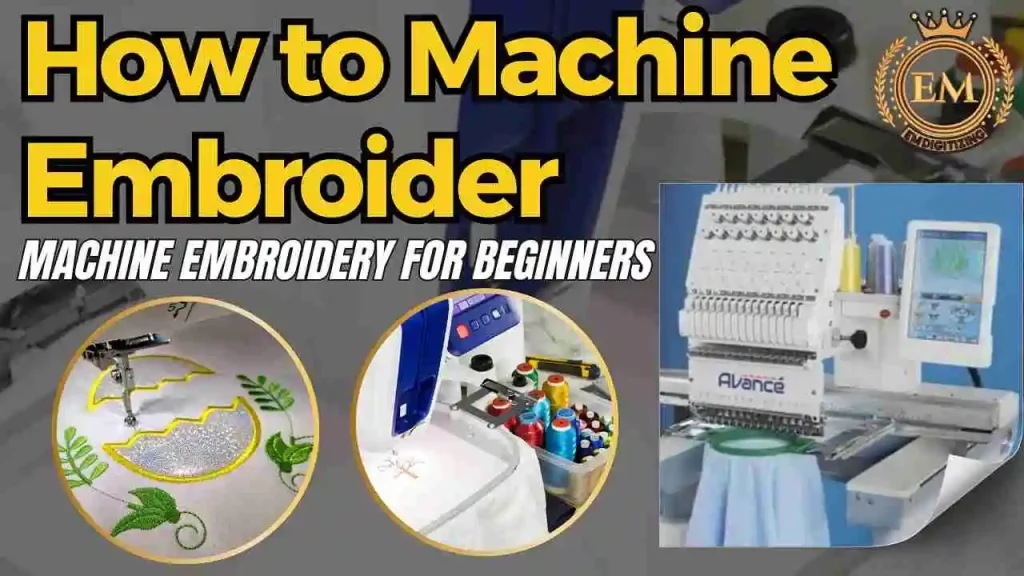
Cómo bordar a máquina | Bordado a máquina para principiantes
¿Qué es el bordado a máquina??
Es un método moderno para agregar diseños a la tela utilizando máquinas de coser avanzadas.. A diferencia del bordado tradicional a mano., Este proceso está automatizado, Permitiendo costuras rápidas y precisas. Cargando un archivo de diseño digital, La máquina trabaja su magia para dar vida al patrón en tu tela..
Con la capacidad de usar múltiples colores de hilos y crear detalles intrincados, El bordado de la máquina es una opción para crear diseños de aspecto profesional en la ropa, accesorios, y decoración del hogar. Es una mezcla de creatividad y tecnología, Perfecto para cualquier persona que busque resultados eficientes y de alta calidad.
Ventajas y limitaciones del bordado de la máquina
Es una forma eficiente de aprender a bordar y crear hermosas diseños de tela. Comprender sus beneficios y limitaciones lo ayudará a lograr los mejores resultados.
Ventajas
- Velocidad y eficiencia: El bordado de la máquina completa los diseños mucho más rápido que el bordado manual, haciéndolo perfecto para proyectos grandes.
- Precisión y exactitud: Asegura costuras impecables, creando patrones intrincados y detallados con facilidad.
- Uniformidad: Produce una calidad consistente en múltiples artículos, haciéndolo ideal para pedidos a granel.
- Versatilidad: Funciona en una variedad de telas, de mezclilla de mezclilla a seda delicada, ofreciendo infinitas posibilidades.
- Rentabilidad: Reduce los costos laborales y aumenta la productividad para proyectos de alto volumen.
- Durabilidad: El bordado basado en hilos es duradero en comparación con otros métodos de impresión.
- Capacidad de diseño complejo: Maneja patrones desafiantes que son difíciles de lograr manualmente.
Limitaciones
- Alta inversión inicial: Las máquinas de bordado y el software pueden ser caras, especialmente para principiantes.
- Curva de aprendizaje: Requiere conocimiento técnico y práctica para operar de manera efectiva.
- Expresión artística limitada: Carece del toque personal y las variaciones únicas del bordado manual.
- Necesidades de mantenimiento: El servicio y el mantenimiento regulares son necesarios para mantener las máquinas en las mejores condiciones.
- Dependencia de la tecnología: El mal funcionamiento de la máquina o el software puede retrasar la producción significativamente.
- Configuración compleja: La preparación de la máquina para el bordado implica pasos que requieren mucho tiempo como el roscado y la configuración de la tela.
Herramientas y materiales esenciales necesarios para el bordado de la máquina
El bordado de la máquina para principiantes puede ser emocionante y gratificante, Pero tener las herramientas adecuadas es crucial para lograr excelentes resultados. De elegir el diseño de bordado perfecto al uso de los materiales correctos, Cada paso juega un papel vital en su viaje de bordado.
- Maquina de bordar
- Hilos de bordar
- Estabilizadores
- Agujas (Agujas de bordar)
- Aros de bordado
- Tela (Algodón, Lino, etc.)
- Tijeras (Pequeño, Los afilados)
- Herramientas de marcado (Bolígrafos o tiza lavables)
- Diseños de bordado prefabricados o diseños personalizados
1. Maquina de bordar
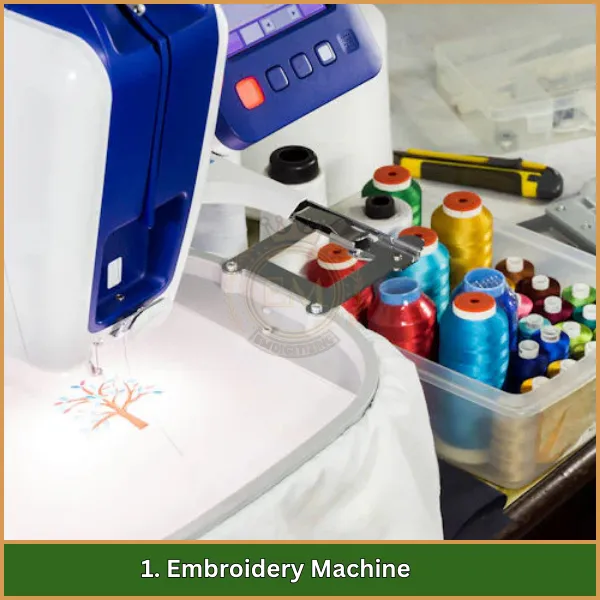
Una máquina de bordado es la herramienta central para cualquier proyecto de bordado. Para principiantes, Es importante elegir el La mejor máquina de bordado para principiantes que es fácil de usar, tiene características automáticas, y ofrece diseños incorporados para practicar con. Máquinas como el hermano PE535 o el bloqueo de bebé Aventura 2 son excelentes opciones, ya que proporcionan diseños precargados y controles fáciles de usar. Comenzando con un simple máquina de bordar para principiantes te ayuda a concentrarte en aprender sin sentirte abrumado.
2. Hilos de bordar
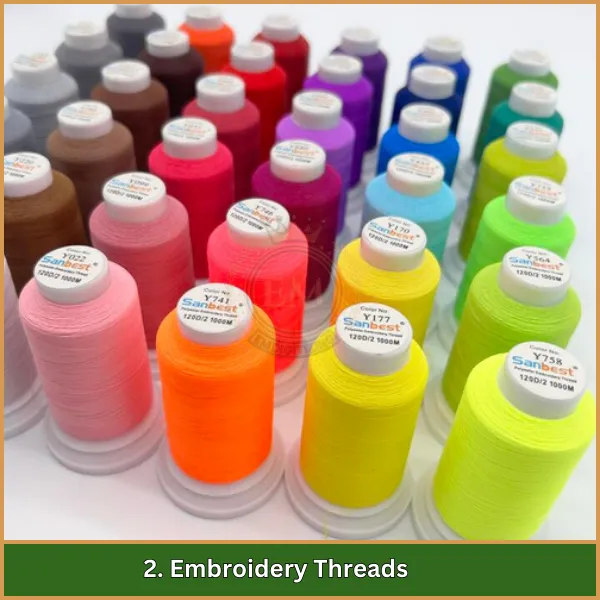
Los hilos son los que dan vida a sus diseños! Los principiantes deben usar hilos de bordado de poliéster porque son duraderos y menos propensos a la rotura. Encontrarás estos hilos en colores vibrantes y puedes comprarlos en tiendas de artesanía., plataformas en línea como Amazon, o tiendas de bordados especiales. Siempre coincida con el tipo de hilo con su proyecto para obtener los mejores resultados.
3. Estabilizadores
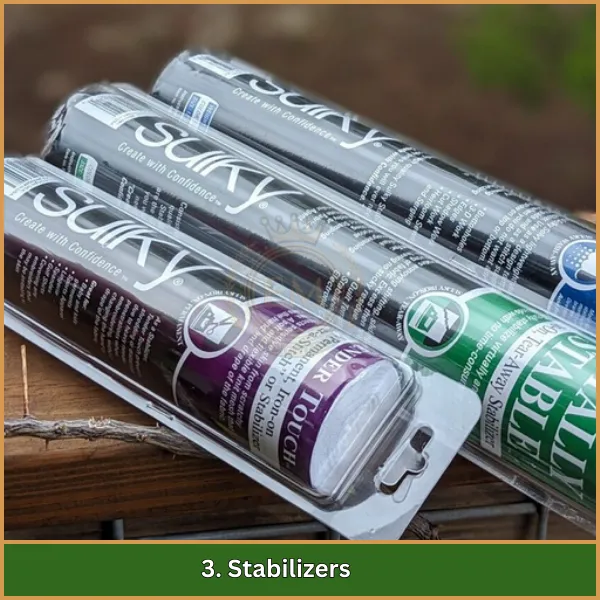
Los estabilizadores evitan que la tela se mueva o se buces durante las costuras. Para principiantes, Los estabilizadores de lágrimas son fáciles de usar y adecuados para la mayoría de los proyectos. Los estabilizadores recortados son mejores para telas elásticas o delicadas, mientras que los estabilizadores lavados son excelentes para proyectos que requieren un acabado limpio. Los estabilizadores se pueden encontrar en tiendas de telas o en línea, y es útil almacenar una variedad para experimentar.
4. Agujas (Agujas de bordar)
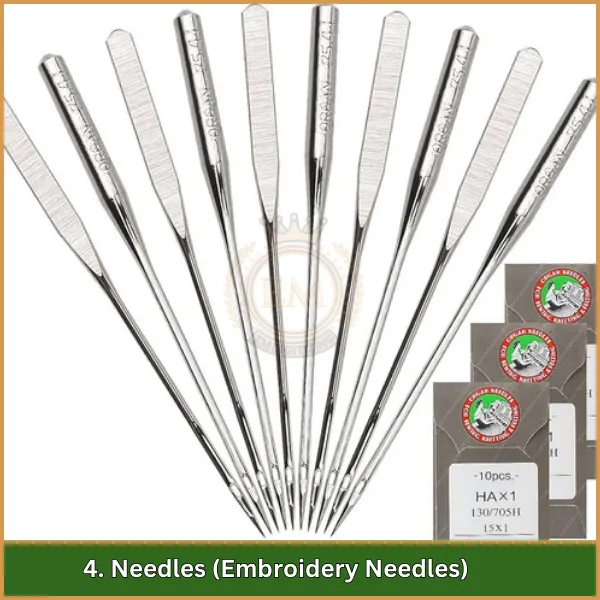
Agujas de bordar están diseñados con ojos más grandes para acomodar hilos más gruesos. Los principiantes deben comenzar con tamaños 75/11 o 90/14, ya que funcionan bien con telas e hilos estándar. Estas agujas están ampliamente disponibles en tiendas de artesanía o en línea.. Mantenga siempre agujas adicionales a mano, Como pueden opacarse o romperse con un uso frecuente.
5. Aros de bordado
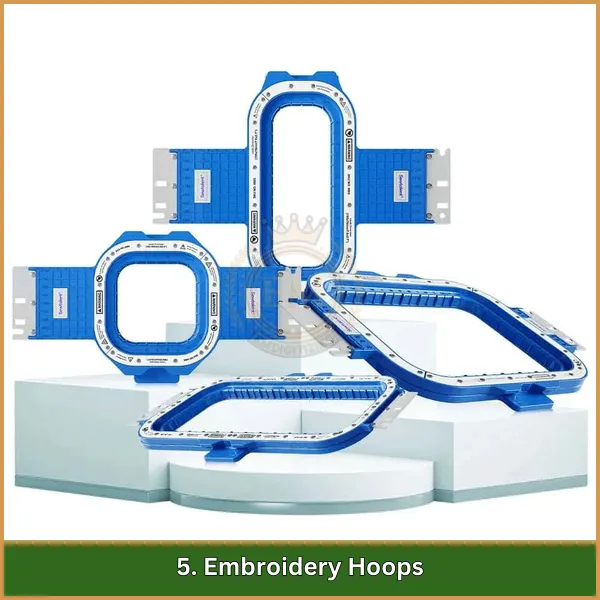
Hoops Mantenga su tela apretada y en su lugar para costuras precisas. como principiante, Comience con un aro de tamaño mediano, Como es más fácil de administrar. Los aros vienen en varios tamaños., y puede comprarlos en tiendas de suministros de bordado o en línea. Si su máquina incluye aros, Asegúrese de familiarizarse con cómo se adjuntan y ajustan.
6. Tela (Algodón, Lino, etc.)
La tela que elija determina el éxito de su proyecto de bordado. Para principiantes, El algodón y la ropa son las telas más fáciles para trabajar porque son resistentes y mantienen bien las puntadas. Evite telas delicadas o elásticas como la seda y la camiseta hasta que tenga más experiencia. La tela está disponible en tiendas de telas locales o grandes minoristas como Joann o Hobby Lobby.
7. Tijeras (Pequeño, Los afilados)
Las buenas tijeras de bordado son cruciales para recortar hilos y cortar pequeños detalles. Busque unas tijeras con un agudo, Consejo puntiagudo para garantizar la precisión. Estos están ampliamente disponibles en tiendas de artesanía y en línea. Los principiantes deben invertir en un par de calidad para evitar la frustración durante los proyectos.
8. Herramientas de marcado (Bolígrafos o tiza lavables)
Las herramientas de marcado se utilizan para rastrear diseños o colocación de marcas en la tela. Los principiantes deben elegir bolígrafos lavables o tiza de sastre para evitar marcas permanentes. Estas herramientas son económicas y se pueden encontrar en tiendas de artesanía o en línea.. Asegúrese de que las marcas se puedan eliminar fácilmente después de la costura para mantener su proyecto limpio y profesional.
9. Diseños de bordado prefabricados o diseños personalizados
Los diseños de bordado son los que hacen que su proyecto sea único. Los principiantes pueden comenzar con diseños prefabricados disponibles en línea en sitios web como BorderyDesigns, Zdigitizing o urbanthreads. Estos diseños vienen en varios tamaños y formatos compatibles con la mayoría de las máquinas..
Si quieres un diseño personalizado, Podemos ayudar! En EMdigitalizando, Ofrecemos servicios de digitalización de bordado personalizados de alta calidad a precios asequibles. Si necesita un logotipo, monograma, o diseño intrincado, lo digitalizaremos a la perfección. Nuestros servicios aseguran resultados de costura sin problemas, y garantizamos diseños de alta calidad adaptados a sus necesidades. Visite nuestro sitio web para explorar más!
Proceso paso a paso para bordado de la máquina para principiantes
Paso 1: Configure su máquina de bordar
Comience configurando su máquina de bordado correctamente:
- Adjunte la unidad de bordado de forma segura si es una parte separada.
- Inserte una aguja de bordado adecuada (75/11 o 90/14) y enhebra la máquina siguiendo las instrucciones proporcionadas.
Paso 2: Seleccione su diseño
Elija un diseño para bordarse:
- Empiece con un básico, Diseño prefabricado para mantener las cosas simples.
- Asegúrese de que el formato de archivo de diseño coincida con la compatibilidad de su máquina.
Paso 3: Prepare su tela y estabilizador
Prepara tu tela y estabilizador:
- Corte un trozo de tela más grande que su aro para evitar bordes apretados.
- Haga coincidir su tipo de estabilizador (arrancar, recortado, o lavado) a las necesidades de la tela y colóquela debajo de la tela para obtener soporte.
Paso 4: Haga su tela correctamente
El aro es clave para un resultado exitoso:
- Coloque el estabilizador en el aro exterior.
- Alise la tela sobre ella para eliminar las arrugas.
- Bloquear ambas capas en su lugar asegurando el aro interno.
Paso 5: Cargue su diseño
Trae tu diseño a la máquina:
- Utilice una conexión USB o una conexión directa para transferir el archivo.
- Navegue por la interfaz para localizar y seleccionar su diseño.
Paso 6: Empezar a coser
Es hora de comenzar a bordar:
- Adjunte la tela de aro a la máquina.
- Configuración de doble verificación como tensión de subproceso y tipo de puntada.
- Presione Inicio y mire la máquina Da vida a su diseño!
Paso 7: Monitorear y terminar el diseño
Esté atento al proceso:
- Esté preparado para abordar las saltos de hilo o las pausas.
- Una vez completado, Retire el aro con cuidado y recorte el exceso de estabilizador y los roscas para un acabado limpio.
Paso 8: Cuida tu artículo terminado
Siga los pasos de cuidado adecuados:
- Lave el estabilizador si es necesario.
- Manejar su tela bordada con cuidado para mantener su calidad.
Este proceso directo lo ayudará a completar con confianza su primer proyecto de bordado.!
Solución de problemas de problemas comunes en el bordado de la máquina
Empezando con bordado de la máquina para principiantes puede ser un viaje divertido y creativo, Pero no es raro enfrentar algunos desafíos. Aquí hay algunos problemas comunes y soluciones prácticas para ayudarlo a crear proyectos de bordado impecables.
1. El hilo sigue rompiendo
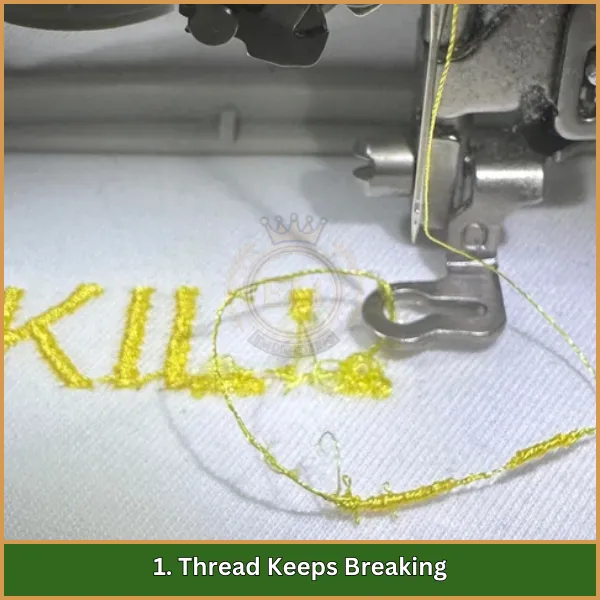
Uno de los problemas más frustrantes es la rotura frecuente de los hilos, que puede interrumpir su flujo de trabajo.
Cómo arreglarlo:
- Verifique la ruta de roscado para asegurarse de que todo esté configurado correctamente.
- Use hilos de bordado de alta calidad para evitar deshilacharse o romperse.
- Ajuste la tensión del hilo a un nivel equilibrado para costuras más suaves.
2. Arrugas o frunces de tela
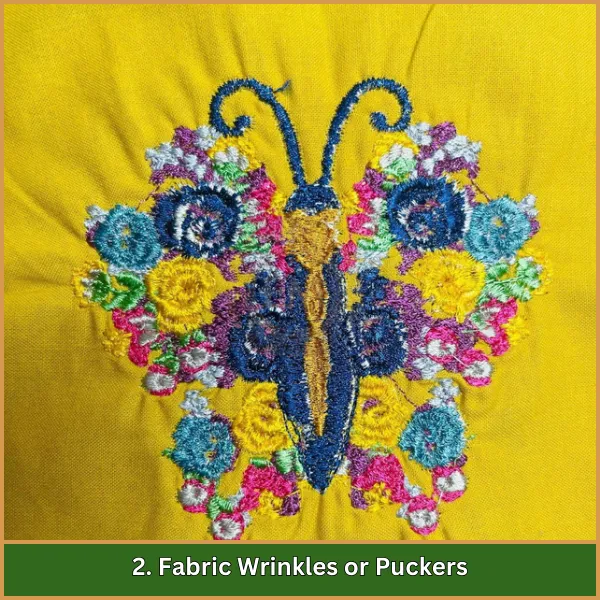
Bucking ocurre cuando la tela alrededor de su diseño se reúne o arrugas, arruinando la mirada final.
Cómo arreglarlo:
- Elija un estabilizador que se adapte al tipo y al peso de su tela.
- Hoop la tela de forma segura, asegurarse de que esté tenso pero no estirado.
- Pon a prueba tu diseño en una chatarra de tela similar para evitar sorpresas.
3. Puntadas saltadas
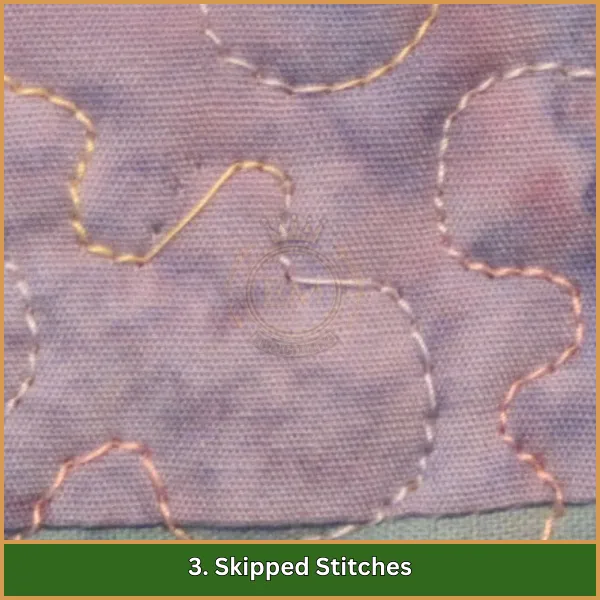
Los puntos faltantes en su diseño pueden hacer que se vea incompleto y no profesional.
Cómo arreglarlo:
- Reemplace la aguja si es aburrida o doblada; Una aguja afilada funciona mejor para el bordado.
- Haga coincidir el tamaño de la aguja con el tipo de hilo y la tela que está utilizando.
- Reduzca la velocidad de la máquina para diseños intrincados o detallados.
4. Hilo enredado debajo (Anidación de pájaros)
Un nido de hilo en la parte inferior de la tela puede arruinar su proyecto y perder el tiempo.
Cómo arreglarlo:
- Limpie el área de la bobina para eliminar la pelusa y los escombros.
- Use una bobina de herida correctamente y asegúrese de que se inserta correctamente.
- Equilibre la tensión de hilo superior y de bobina para coser suaves.
5. Máquina que funciona demasiado lentamente
Una máquina de carrera lenta puede hacer que el bordado se sienta tedioso.
Cómo arreglarlo:
- Verifique la configuración de la máquina y ajuste la velocidad para su proyecto.
- Realizar mantenimiento regular, incluyendo limpieza y engrasamiento, Para mantener su máquina en buenas condiciones.
6. El hilo inferior no está recogiendo
Si la máquina no está atrapando el hilo de la bobina, No coserá correctamente.
Cómo arreglarlo:
- Reemplace una aguja doblada o opaca por una nueva.
- Rethread tanto los hilos superior como inferior, Siguiendo el manual de la máquina para su precisión.
7. Marcas de aro en la tela
Las marcas de aro pueden dejar impresiones no deseadas en telas delicadas, Restar su trabajo terminado.
Cómo arreglarlo:
- Use aros magnéticos o evite que la tela estuviera demasiado bien.
- Retire las marcas al vapor suavemente o lavando la tela después del bordado.
Conclusión
Comenzar con el bordado de la máquina para principiantes abre la puerta a infinitas posibilidades creativas. Con un poco de práctica y el enfoque correcto, Puedes dominar el arte de transformar telas simples en obras maestras personalizadas. Cada puntada te acerca a perfeccionar tus habilidades y explorar nuevos y emocionantes proyectos.
Para llevar su bordado al siguiente nivel, Confía en Emdigiting para todas sus necesidades de digitalización. Ofrecemos una calidad superior servicios de digitalización a precios inmejorables, Garantizar tiempos de respuesta rápidos y resultados excepcionales. Más, Nuestra opción de vista previa única le permite ver su diseño antes de que se finalice, para que sepas exactamente qué esperar.
Si eres nuevo en Emdigitizing, Tenemos un regalo especial para usted, disfruta de una exclusiva 50% descuento en tu primer pedido! Permítanos ayudar a convertir sus ideas creativas en impresionantes diseños de bordados. Visita EMDigitalización hoy y experimenta la diferencia!
preguntas frecuentes
Comience por elegir una máquina para principiantes y recolectar suministros como subprocesos, agujas, y estabilizadores. Use tutoriales en línea y kits para principiantes para practicar a su propio ritmo. Unirse a las comunidades de bordado para obtener consejos, apoyo, y retroalimentación.
Una máquina de aguja única con controles fáciles y diseños incorporados, como el hermano PE535 o Janome 400e, es ideal. Busque modelos con instrucciones claras y recursos de soporte. Estas máquinas hacen que el aprendizaje sea simple y agradable.
Familiarícese con su máquina de bordado leyendo el manual y practicando subprocesos. Comience con patrones simples en la tela de chatarra para generar confianza. Moverse gradualmente a diseños complejos a medida que sus habilidades mejoran.
Configurar y enhebrar la máquina, Luego seleccione y cargue su diseño. Aro y estabilice su tela de forma segura antes de comenzar el bordado. Termine recortando hilos y eliminando exceso de estabilizador.
